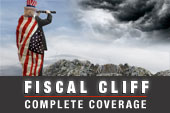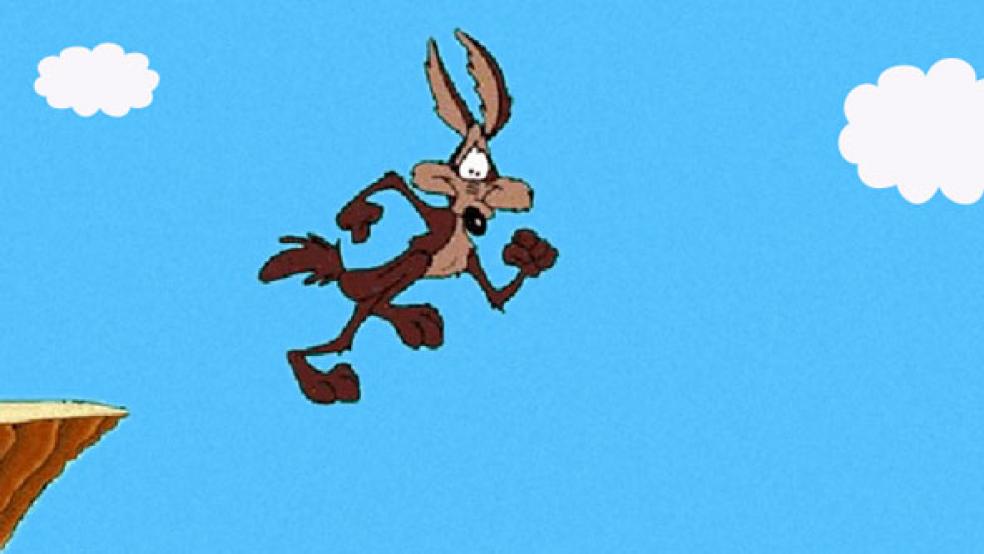The debate over the fiscal cliff in less than seven weeks has produced some amusing attempts to capture the moment through common cultural references National Journal reported last week that some Democrats in Congress believed that the deadline at the end of the year was mostly a media chimera, and that a delayed response would do no significant damage.

Economists rebutting this view recalled the old Warner Brothers Looney Tunes cartoons, where characters ran off cliffs and stood suspended in midair for a moment or two before plunging to their destruction.They warned that passing the year-end deadline would produce exactly the same kind of reaction in the economy -- that a momentary stall would pass immediately into a collapse.
I have a different entertainment image in mind when imagining the political class' approach to the fiscal cliff: Thelma and Louise. The two parties have any number of people chasing after them, trying to get them to act rationally, while the pair in the front seat lock hands and make a spectacular vault off the cliff at high speed. Unless leadership in both parties get the mandate for coexistence and cooperation voters communicated last week, we're likely to see the political equivalent of the film's end, minus the empowerment it symbolized as the car went over the cliff.
To extend the entertainment analogy even further, this standoff is like a Hollywood film trilogy – and only if we're lucky will we avoid a fourth installment. The issues involved were the exact same issues that confronted Congress and the White House at the end of 2010, after the midterm elections flipped the House to Republican control. Massive deficit spending combined with anemic growth had forced the US to extend the debt limit and to address the expiration dates of the Bush-era tax rates that had been in place for seven years or more. Instead of solving the problem, Republicans and Democrats could only agree to temporary measures that pushed the hard questions of spending and revenue choices off a few months.
The first summer sequel wound up an even more contentious affair as both parties eyed the upcoming presidential election, and added a new cliffhanger, pun intended: sequestration. The automatic cuts triggered were supposedly so bad that it would force Barack Obama, Harry Reid, and John Boehner to cut some sort of a deal after another big hike in the nation's debt limit, which came too late to avoid the first downgrade in American credit ratings in nearly a century. Despite warnings from Obama's own Secretary of Defense, Leon Panetta, of the danger to national security that sequestration produces, neither side budged -- and the Senate didn't even bother to propose its own budget for the third year in a row.
Finally, now we have the third installment of the series, where none of the problems have been solved, and where all of them converge. We still have the question of the Bush-era tax rates, expiring again after the two-year reprieve from 2010. Sequestration has been added to the mix, and we still have no budget from the Senate and yet another trillion-dollar deficit. On top of that, the credit ratings agencies may re-evaluate US credit downward again if Washington can't come up with a solution, which will make the borrowing that enables the deficit spending even more costly by driving deficits up faster.
Has our political class learned anything from the first two installments? Not so you'd notice. While Boehner has offered to return to the so-called "grand bargain" offered in a brief moment of hope in August 2011 that would have added $800 billion in new revenues, Obama has refused to offer a reasonable compromise. He gathered left-leaning business leaders Wednesday to pitch his proposal to demand twice as much in new revenue, while postponing any spending cuts and locking in current tax rates for middle-income earners.
Obama’s demand for $1.6 trillion in new revenue over the next decade came at an interesting moment. His proposal would add an average of $13.3 billion a month over the next ten years. Two days earlier, the Treasury Department reported that the deficit for October 2012 came in at $120 billion, far ahead of the pace projected by the OMB for their calculation of a $991 billion annual deficit for FY2013.
That’s an increase from October 2011’s $98 billion deficit, but that didn’t come from a lack of revenue; revenue actually increased by $21 billion, about 150 percent of the additional revenue Obama claims to need to avoid the fiscal cliff. Spending rose $42 billion over the previous October, twice the additional revenue received, and more than three times the amount of additional revenue Obama now demands.
During the presidential campaign, Obama insisted that he would be open to a compromise solution to the fiscal cliff, as long as it was “balanced.” Jim Pethokoukis analyzed the latest proposal from the White House to determine what “balanced” means to President Obama. “Of the supposed savings, then, $1.6 trillion comes from tax hikes, $577 billion comes from spending cuts, not counting saved interest,” Pethokoukis writes for AEI. “So 73 percent of the savings comes from taxes, 27 percent from spending cuts. That’s $3 of tax hikes for every $1 of spending cuts.”
Furthermore, as Jackie Leo pointed out here at The Fiscal Times, the tax hikes Obama has in mind make it less likely to get the kind of revenue increases Obama expects. The consumer-driven economy needs to get more discretionary spending into play, not less, and taxing households with more will produce lower growth. Thanks to increases in taxes already in place at the state level, we’ll see that happen anyway.
Depending on where these $250,000+ households are located, their cost of living will keep that discretionary spending even lower. And that doesn’t take into account the depressing effect of higher taxes on capital investments, which the economy sorely needs in order to add jobs and produce real growth in the next few years. Without that level of growth, the actual revenues will get scaled down to where the ratio of tax hikes to actual revenue will be higher than the 3:1 predicted by Obama’s static analysis – perhaps a lot higher.
The better way to resolve the fiscal cliff is an approach that solves the main problem of rapidly-increasing spending and producing better revenue through economic growth and tax reform. Both parties want to reform the corporate and personal tax systems to eliminate complexity and provide stability and predictability. Rather than aim specifically at revenue, start by realizing the bipartisan goal of tax reform, which will boost investor confidence, and then address the spending that drives the deficits. That will be the only way to have a truly balanced long-term solution and a reliable increase in revenue, one that will keep America on a firm path to solvency.
If Obama won’t back down from his obstinacy focused on “fairness” rather than success, then we can expect to see yet another dive off of the political cliff in a beaten-up political vehicle, with the President’s one hand firmly gripping the wheel, and his other dragging the entire cast and crew over the precipice. The best-case outcome in that Looney Tunes circumstance would be yet another sequel to this tired cartoon of political leadership in times of economic crisis.






